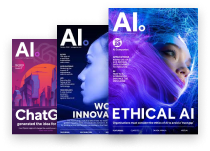Given that humans rely on language for communication, it logically follows that AI systems also require language to communicate effectively.
Back in 1966, Eliza, the first chatbot was developed by Joseph Weizenbaum. It was considered one of the first computer programs to use a basic form of a language model. Although with limited response ELIZA was already breaking the barriers!
Eliza was the first chatbot to introduce the (Natural Language Processing)NLP program which paved the way for the development of sophisticated language models in the future. NLP laid the foundation for future advancements, culminating in the creation of large language models (LLMs). These powerful models can perform a diverse array of tasks, including text classification, language translation, and text generation.
LLMs are trained in two steps:
- First, they learn the meaning of words and how they fit together.
- Second, they’re taught to understand relationships between things using a special technique called self-attention.
After training, LLMs can do many things, like writing, translating, summarizing, having conversations and even computing mathematical functions. They’re particularly useful for any entrepreneur because they’re fast, accurate, and easy to work with. They are brain to AI!
Large language models (LLMs) can be trained to perform a variety of tasks. One of their most notable applications is generative AI, where they can produce text in response to a prompt or question.
For example, the publicly available LLM Chat GPT can generate essays, poems, and other forms of text based on user inputs.
Moreover, LLMs can be trained on any large, complex datasets, including programming languages. This enables them to assist programmers in writing code. They can create functions upon request or complete a program given a starting point, making them a valuable tool for developers.
The Architecture of LLMs
1. Encoding: Encoding is the basic component of LLM. Its primary function is to convert input text into meaningful numerical representations, known as embeddings after the text has been tokenized into individual words or tokens.
These embeddings are designed to capture the semantic relationships between words, positioning words with similar meanings near each other in vector space.
This allows the model to better understand the context and relationships between words in the input text.
2. Self-Attention: As we all know LLMs do require parental attention all the time! LLMs selectively focus on specific parts of the input text when generating output. This is particularly useful when dealing with long-range dependencies or relationships between words in the input text. Many of us mistake attention mechanismas a separate part, rather it is an integral part of the overall architecture.
They allow the model to weigh the importance of different input elements and allocate its attention accordingly.
3. Decoding: It is the final component of the LLM architecture. It is responsible for converting the output from the encoder and attention mechanisms back into human-readable text.
During the training process, the decoder predicts the next word in a sequence, given the context of the previous words. This process is repeated millions of times, allowing the model to learn patterns and relationships in language. Once trained, LLMs can perform a wide range of tasks, including answering questions, language translation, semantic search, and communication!
Extension of Large Language Models
- LaMDA-It is used across various Google properties such as Google Search, Google Assistant, and Workspace. It’s also used to provide recommendations based on user queries. LaMDA 2, an upgraded version of the model, was announced at Google’s 2022 I/O event and is more finely tuned to provide better responses.
- GPT-3, or the third-generation Generative Pre-trained Transformer-It is a neural network machine learning model trained using internet data to generate any type of text. It is developed by Open AI and requires a small amount of input text to generate large volumes of relevant machine-generated text.
- BERT, or Bidirectional Encoder Representations from Transformers-It is a pre-trained language model developed by Google in 2018. It’s designed to understand the context of a given text by analyzing the relationships between the words in a sentence, rather than just looking at individual words in isolation.
Key Features:
- Easy summarization: LLM can efficiently summarize any lengthy boring content, such as articles, news research, reports, and corporate documentation, and reads customers’ history into concise and thorough texts tailored to the desired output format. It also enables users to grasp the major features and main ideas of complex content. Therefore, saving time and effort.
- Language translation– One of the major benefits of LLM is that it provides organizations with a wider reach across languages and geographies, facilitating communication and collaboration. With fluent translations and multilingual capabilities, language barriers are bridged, and global interactions become more seamless.
- Code generating– LLMs help developers build applications more efficiently, identify errors in code, and detect security issues in multiple programming languages. Moreover, it can translate between programming languages, streamlining the development process and enhancing productivity.
The Drawbacks
When we learn about the benefits of LLM, we must know about the drawbacks too! LLMs sometimes can hallucinate! Yes, you read that right!
It can create fake information when they are unable to produce an accurate answer (narcissistic, I must say).
For example; In 2022, Fast Company asked Chat GPT about Tesla’s previous financial quarter, and Chat GPT generated a coherent news article in response. However, it was later found that much of the information in the article was fabricated. This incident highlights the issue of hallucination in AI models, where they generate information that is not based on actual data or facts.

As Simon Willison said “These are incredibly powerful tools. They are far harder to use effectively than they first appear. Invest the effort, but approach with caution: we accidentally invented computers that can lie to us, and we can’t figure out how to make them stop”.
Conclusion
Large Language Models (LLMs) have emerged as a key area of focus in the field of Artificial Intelligence, particularly following the release of Cha tGPT in November 2022. This event triggered a significant increase in the development of advanced multimodal models and a thriving open-source environment for AI.
Currently, LLMs are among the top 14% of all emerging technologies. It not only signifies to creation of new job roles but also disrupts existing jobs!




